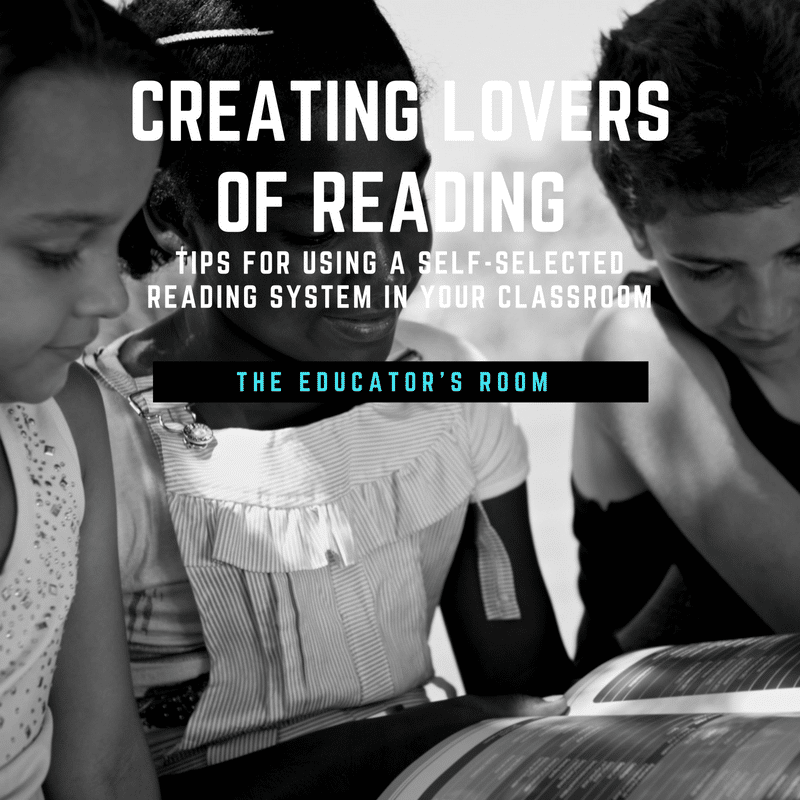Students come to us with reading levels all over the spectrum. As a new teacher, one of the biggest challenges in my heterogeneous classes was assigning and monitoring their reading.
While challenging students with complex texts is not only important but required, it is still essential that our students read and read and read even more. Whether we like it or not, handing them all the same book–our selection–when they walk through the door has the potential to ruin that book, its author and maybe even reading overall for everyone but the best and most open-minded readers.
So how do we get them reading without making them hate it?
During my first few weeks as a teacher, I was convinced by several colleagues to try a self-selected model. Six years later, I am still using self-selected reading as the backbone of literature requirements in my English classes. It’s easier than you’d think, and most importantly, students actually read. Many fall in love with reading having never realized the amazing literature that is available for young adults. Many students (and parents!) tell me that they read more for my class than they ever have before, and I have many students who finish entire books for the first time in their lives.
Reading and loving reading is so important. We certainly read challenging, canonical class texts sometimes, but having a system for self-selection and making it a priority can change your students’ entire outlook on reading.
Some tips from my experience for those taking the plunge:
Make silent reading part of class. Yes, it will cost you class time (as a new teacher, it was a great opportunity to regroup, get an idea of the energy in the room and mentally prepare for the lesson). When everyone’s reading a different book, you’ll need some time to manage the reading and chat with students about their books and reading choices. I start class with a half-page of writing and expect my students to transition immediately into reading when they are finished with their writing. I use the time to do I-finished-my-book talks, check homework, take attendance and pull students aside to meet one-on-one. The half hour is over before I know it and now I don’t know what I’d do without that time. In-class reading also sets momentum: If you can get them reading something engaging during class, they’re more likely to bring it home and continue. Sadly, for some students reading at home is just not an option, and for them, reading in class is all they will ever do.
Keep reading logs yourself. Shockingly, students aren’t necessarily responsible all the time. Having them keep a log of their out-of-class reading time often ends in dishonesty, lost papers and lots of grade book holes. Instead, ask students for their page numbers both at the beginning and at the end of reading time in class and record them yourself. This works for me on several levels: First, I get a feel for how many pages they read in that amount of time and can adjust my homework expectations for each student accordingly. Second, since they don’t have the record, they don’t know what they told me last time which makes it a little more difficult to lie about how much reading was done at home. Lastly, if you keep the records then they don’t get lost, which keeps your grade book complete. I give students 20 points per day for reading at home, and after five classes I enter homework reading grades out of 100 points. You can also assign a grade for good reading behavior during class, at least until students understand and rise to your expectations for that time.
Let students quickly and easily prove when they have finished a book. They should do it immediately after finishing, but it should be simple. Having to do a project, write a summary or other paper every time doesn’t encourage reluctant readers to finish books. Instead, have them write a quick quiz about some details in the book and keep it for others who read that book later. Not familiar with the book? The easiest way to check is a quick book talk: Grab the book yourself and open it to a random page. Read aloud until the student can tell you what’s going on. Flip back and forward a page or so to make sure they’re right. You’ll be surprised how easily you can tell, even if you haven’t read the book. If you want to require students to use their reading to complete essays, presentations, and other classwork later, that’s great–just don’t make them do it in order to get credit for the book. It should be simple to check off one and start the next.
Push individual students toward titles appropriate for them. Show struggling readers shorter titles with small chapters. Push higher readers toward college-bound reading lists. Better yet, make students aware of their reading levels and have them look up whether the book they’re reading matches up (we use Lexile levels for this). As you get going and begin talking to kids about what they’re reading, you’ll get a feel for titles in your library you haven’t read in addition to familiar texts. Now I am able to make a stack of recommended books for any student looking through my library, and they rarely get through the pile without finding something at least initially interesting.
[fusion_builder_container hundred_percent=”yes” overflow=”visible”][fusion_builder_row][fusion_builder_column type=”1_1″ background_position=”left top” background_color=”” border_size=”” border_color=”” border_style=”solid” spacing=”yes” background_image=”” background_repeat=”no-repeat” padding=”” margin_top=”0px” margin_bottom=”0px” class=”” id=”” animation_type=”” animation_speed=”0.3″ animation_direction=”left” hide_on_mobile=”no” center_content=”no” min_height=”none”][bctt tweet=”Now I am able to make a stack of recommended books for any student looking through my library” username=”EducatorsRoom”]
Have a classroom library of current popular young adult literature. Whether it’s right or not, our kids do judge books by their covers and having a shelf of antiquated classics–no matter how timeless they are–won’t cut it. My school library is wonderful and our staff welcoming and friendly, but some students just won’t use it. Should they? Absolutely. But many won’t, and the point here is to get books in front of all kids. Not swimming in personal cash for classroom books? Once your school realizes the benefits of self-selection, they may jump onto the “book flood” bandwagon and set aside English department money for independent reading books. Not happening in your district? Try submitting a Donors Choose project or asking students to donate unwanted books from home. Goodwill, Salvation Army, and library book sales are great ways to get cheap titles one or two at a time.
[bctt tweet=”My school library is wonderful and our staff welcoming and friendly, but some students just won’t use it.” username=”EducatorsRoom”]
Know your library! Read the books and explore book blogs. These days, “young adult” literature is an incredibly diverse, ever-expanding, completely enthralling genre. Gifted authors are writing captivating stories on every possible topic, and the best way for you to get your students excited about reading is to be able to tell them about amazing books you’ve read and recommend. Follow book blogs–my favorite are Bookshelves of Doom and Guys Lit Wire–and create a wish list on your favorite online bookseller’s website. You may have a family member or Facebook friend who would donate to your classroom library once in awhile.
Self-selected reading can be a daunting change in how you approach reading in your classroom, but I assure you it is a rewarding and worthwhile one. Remember: It’s about reading a lot and loving it. You do, and so should they!
 [/fusion_builder_column][/fusion_builder_row][/fusion_builder_container]
[/fusion_builder_column][/fusion_builder_row][/fusion_builder_container]






I found the lure of chapter books was a challenge for early readers. They wanted to declare they were reading chapter books but they often proved too taxing. I would get 3 books and tell them if you read these at your level it will be like you've read only 1 chapter book. Still, the ability of declaring 'I read chapter books' is hard.
Very encouraging tips to increase reading habit!! I'm reading geek and everyday spends most of the day gaining knowledge reading through novels and all. Anyway thanks for such come up. I think above mentioned tips will be very effective to use self-selected reading system in classroom.